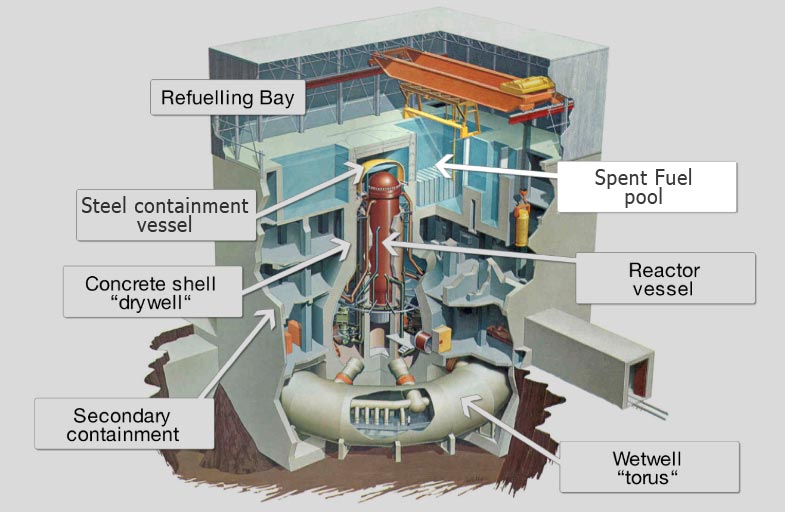One of the big problems with nuclear reactor safety is the fact that a common design for reactors from General Electric put the cooling pool for the spent fuel rods four stories above the ground in the reactor building. If the cooling systems fail and water drains from the cooling pool exposing the spent fuel rods, they will spontaneously burst into flame. This was one of the main concerns at Fukushima when the emergency generators failed due to flooding and there was no power to keep the pumps going to supply water to the spent fuel pools. There are twenty commercial power reactors in the U.S. that have the old G.E. design.
Following the Fukushima disaster in 2011, national governments including the U.S. reviewed the design of reactors and safety procedures to see if they needed to be revised in light of what happened at Fukushima. Now the U.S. Nuclear Regulatory Commission (NRC) has been challenged with respect to its assessment of the dangers posed by fires in spent nuclear fuel cooling pools.
An article written by researchers from Princeton University and the Union of Concerned Scientists just published in the journal Science claims that the NRC “relied on faulty analysis to justify its refusal to adopt a critical measure for protecting Americans from the occurrence of a catastrophic nuclear-waste fire at any one of dozens of reactor sites around the country.” The article goes on to say that the fallout from an accident that was the result of failing to adopt the measure could be even greater than the fallout from the Fukushima disaster.
U.S. spent fuel pools are overcrowded because there is no permanent spent fuel repository in the U.S. Some of the spent fuel is being transferred to dry cask storage but much more needs to be move out of the pools. It is estimated that if much of the spent fuel is not removed from U.S. reactor cooling pools within five years, some reactors may have to be shut down because there is no place to put more spent fuel.
The current density of the spent fuel rods in U.S. reactor cooling pools is so great that a fire at one of them could release enough radioactive particles into the atmosphere to seriously contaminate an area twice the size of New Jersey. That would be over seventeen thousand square miles. It is estimated that as many as eight million people might have to be relocated and the cost could rise to two trillion dollars.
The article in Science magazine points out that a terrorist attack could lead to a fire at a nuclear power reactor but the NRC refused to consider terrorist attacks when reviewing risks at nuclear power plants. In addition, the NRC also refused to consider any damage caused by a fire at a nuclear power plant that was more than fifty miles away for the site of the plant and the fire. Failing to take these and other dangers into account caused the NRC to seriously underestimate the dangers posed by nuclear power plants.
One of the authors of the article suggested that pressure on the NRC from the nuclear industry and nuclear industry-friendly Congressmen was one of the reasons for the underestimation of risks. The nuclear industry is in serious trouble in the U.S. due to cheap oil and natural gas as well as dropping price for wind and solar. If the full risks of nuclear power were properly assessed by the NRC, the result might be the closure of more nuclear power plants in the U.S.
Diagram of Fukushima Nuclear Reactor:
